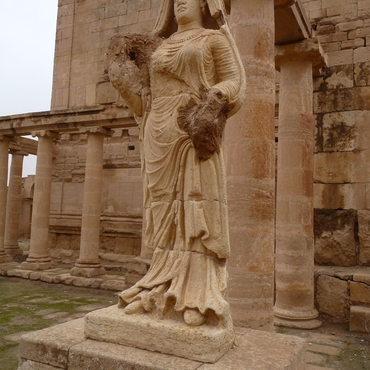
The sculptural art at Hatra is remarkable, be it the steles, the statues or the bas-reliefs adorning monument walls.
Parthian art
The monuments of Hatra are particularly representative of Parthian art. The reliefs, architecture, sculpture, inscriptions and other remains found during the excavations provide a glimpse of the daily life of this Parthian city in Northern Mesopotamia. The Parthian period is still being researched, and the documentation from Hatra gives us extraordinary insights into Parthian society, culture and religion. These works are decorated with a variety of motifs — floral and geometric patterns, as well as human and animal representations. The capitals and architraves, however, show a strong Greco-Roman influence.
Votive sculptures
Excavations uncovered many sculptures carved in limestone and alabaster inside the sanctuaries. Given their small size, these must have been votive offerings. They represent local deities and are often inscribed in Aramaic, which allows us to know the name of the deity and of the dedicator.
One of these, the statue of King Athal, originally stood in the temple dedicated to Baalshamin. It was displayed in the Mosul Cultural Museum before it disappeared during the Daesh occupation. Another statue depicted a warrior prince dressed in Roman costume — wearing sandals and standing on a pedestal. The statue, which also disappeared in the looting of the museum, was a particularly good example of the influence of Roman art in this city.
Exceptional bas-reliefs
The Hatra Hall of the Mosul Cultural Museum also had reliefs on display, all of which disappeared during the occupation by Daesh.
One of these represents three women and a man face on, side by side, wearing cylindrical ribbed caps. Dressed in a long robe and sandals, the man holds what looks like a thunderbolt in his left hand. The women wear thin shirts and dresses that reach down to their feet. Their necks are adorned with beads and pendants, and they hold palm leaves and branches of fruit trees. The scene on this relief, which was found in a Greek-style temple, likely represents a god and three goddesses.
Another painted relief, also now missing, seems to represent Nergal, the god of war and hell. His terrifying head is horned and topped by a falcon. Holding a snake-shaped axe and a sheathed sword, he is surrounded by snakes, scorpions and a three-headed dog. To his right stands a mast decorated with various banners, and on his left is a goddess seated on a throne. The iconography seems to refer to the myth of Ishtar's descent into the underworld, which was later taken up and assimilated by the Greek world into the myth of Heracles' descent into the underworld.
Associated media
Open Media Library

Low relief, Hatra, 2010

High Relief, Hatra, 2010

High Relief, Hatra, 2010

High Relief, Hatra, 2010

Low relief, Hatra, 2010

Animal representations in relief, Hatra, Iraq, in 2008

Three-dimensional reconstruction of a relief from Hatra

Statue of King Athal, Mosul Cultural Museum

Statue of the Warrior Prince, Mosul Cultural Museum

Plaque of the "God of Hell", Mosul Cultural Museum
